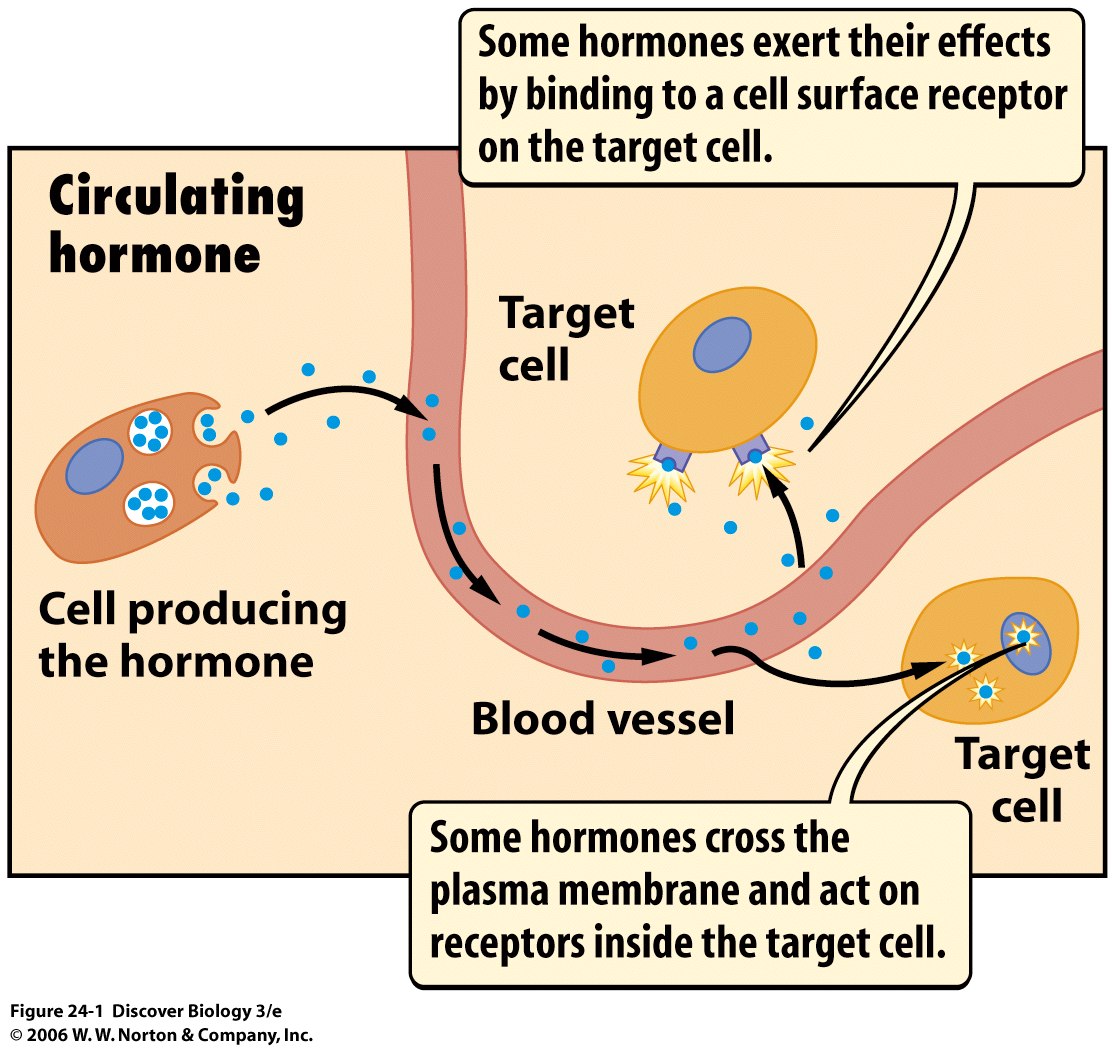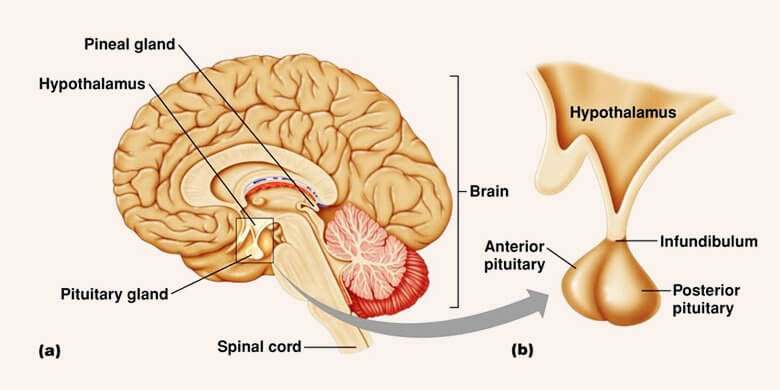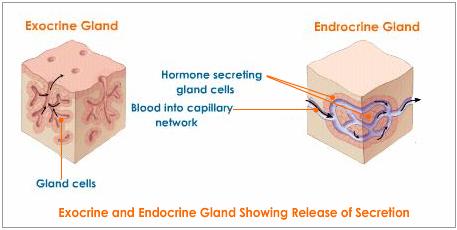THE ENDOCRINE
SYSTEM
The
Endocrine system refers to the glands of organisms that secrete hormones
directly to the circulatory system which transports them to the target organs.
Do not confuse this system with the exocrine system which secretes hormones
using ducts. The effects of the hormones secreted by this system are relatively
slow to initiate, resulting in a prolonged response which may last for a few
hours, days or even weeks.
The Endrocrine and Nervous System
Note
that since the endocrine system is a signalling system, it is closely related
to the nervous system yet both are significantly different from one another.
Why?
In
order to describe why, we must first know their individual functions. While
both systems deal with the transfer of signals, they differ in the manner or
medium used. The nervous system utilizes vast networks of neurons to convey
signals while the endocrine system uses glands and are located throughout the
body. In general, both systems are related structurally, chemically and
functionally.
Many of the endocrine system’s glands are rooted and regulated by parts of the nervous system. Such part is the hypothalamus which controls posterior pituitary gland activities. Regulation of the pituitary gland is achieved through the release of various “releasing and inhibiting hormones” such as GHRH & GHIH (Growth Hormone Releasing/Inhibiting-Hormone), TRH (Thyrotropin Releasing-Hormone) and many others. The relation of both systems is seen in this mechanism as these hormones, among others, are released by the hypothalamus. Overall, the nervous system acts as the regulating factor for the secretion activities of the endocrine system as evident in the dependence of the release of hormones from the glands on the hormones released from the brain.
Many of the endocrine system’s glands are rooted and regulated by parts of the nervous system. Such part is the hypothalamus which controls posterior pituitary gland activities. Regulation of the pituitary gland is achieved through the release of various “releasing and inhibiting hormones” such as GHRH & GHIH (Growth Hormone Releasing/Inhibiting-Hormone), TRH (Thyrotropin Releasing-Hormone) and many others. The relation of both systems is seen in this mechanism as these hormones, among others, are released by the hypothalamus. Overall, the nervous system acts as the regulating factor for the secretion activities of the endocrine system as evident in the dependence of the release of hormones from the glands on the hormones released from the brain.
Both
systems use the same transmitter known as norepinephrine,
the only difference is the manner by which it is used. The nervous system
utilizes norepinephrine as a neurotransmitter while the endocrine utilizes it
as an adrenal hormone.
In
terms of function, the endocrine and nervous system work in unison to relay and
generate hormonal change; maintenance of homeostatis is one of the results of
this cooperation. An example of both systems working in conjunction is the
mechanism for milk release. Sensory cells in the nipple of the mother send
signals to the hypothalamus when the baby sucks on the mother’s nipple. This
stimulates the release of oxytocin from the posterior pituitary, a hormone that
promotes the movement of milk in the breast. From this example, we can discern
that the nervous system acts as a receiver of stimulus in such physiological
functions.
Exocrine and Endocrine Glands
As stated above, the exocrine and
endocrine systems are both signalling systems that use hormones released by
glands but there is a clear distinction between the two. To discuss this
further, what is the difference between an exocrine gland and endocrine gland?
Exocrine
glands have ducts - and they secrete
onto a surface: examples of exocrine glands are: sebaceous and sweat glands (in
the skin), salivary glands (oral), Brunner's glands. Covering their basic
structure and function in tissue types, and observing several examples of
exocrine glands in other topics. Exocrine
glands can be Unicellular - Goblet cells, or Multicellular.
On the other hand, Endocrine glands do not have ducts. Their secretions (hormones) are secreted into the blood stream. Because of this, the hormones can act over long distances, and reach any organ in the body to co-ordinate activity. Often there is a specific 'target' organ that the hormone acts on. This long range activity is also often called neuroendocrine - as it is somewhat analogous to the co-ordinating activity of neurones. Some short range endocrine activity also occurs in the digestive system - and this is known as paracrine activity- for example, enteroendocrine cells of the gut respond to activity by secreting peptides of monoamines that act locally. The secretory cells of endocrine glands are therefore always found in close proximity to a capillary bed, and have a rich network of blood vessels. The signalling molecules released - hormones, are usually released by exocytosis, by the secretory cells, into the interstitial spaces and pass through fenestrated capillaries to enter the blood stream and move to target organs. The target organs will have specific receptors for the hormone, and can respond when the hormone binds.
Hormones
Now,
the word hormone is used frequently in the discussions above. What exactly is
this word anyway?
 Hormones
are organic chemical substances released by a cell, or organ or a gland or any
body part of plants and animals that functions in the regulation of
physiological activities and to maintain homeostasis. The chemical
discharged from one part affects the cells in other part of the organism.
Hormones are released in very minute quantities. Minute quantity of hormones carries out functions evoking responses
from the target organs or tissues. The target organs or tissues are adapted to
the minute quantities of the hormones. Hormones act as chemical messengers that
transport signal from one cell to the other. Hormones are transmitted to
their target organs in the blood stream after they are discharged from the
glands secreting them. Cells express a specific receptor molecule to the
hormone molecules to which they respond. Endocrine secretions are the mode
of discharge directly into the bloodstream. General characteristics
of hormones are as follows:
Hormones
are organic chemical substances released by a cell, or organ or a gland or any
body part of plants and animals that functions in the regulation of
physiological activities and to maintain homeostasis. The chemical
discharged from one part affects the cells in other part of the organism.
Hormones are released in very minute quantities. Minute quantity of hormones carries out functions evoking responses
from the target organs or tissues. The target organs or tissues are adapted to
the minute quantities of the hormones. Hormones act as chemical messengers that
transport signal from one cell to the other. Hormones are transmitted to
their target organs in the blood stream after they are discharged from the
glands secreting them. Cells express a specific receptor molecule to the
hormone molecules to which they respond. Endocrine secretions are the mode
of discharge directly into the bloodstream. General characteristics
of hormones are as follows: - Hormones are secreted by endocrine cells.
- Hormones are chemical messengers.
- They are chemical signals that circulate in the body fluids.
- The hormones regulate the behavior of the target cells.
- Hormones, unlike enzymes do not catalyze any reaction.
- They are secreted only when needed, they are not stored prior to requirement.
- Hormones may be proteinaceous or non-proteinaceous in nature (amino-acids or steroids).
- The secretion of hormones is regulated by the nervous system through the feedback effect.
- Hormones usually cause long term effects like change in behavior, growth, etc.
- The hormones function is to stimulate or inhibit the target organs.
Steriodal and Non-steroidal Hormones
There are actually two
classifications of hormones namely the steroidal hormones and non-steroidal
hormones. What are these two?
Steroid hormones are
hormones that have a
cholesterol backbone and are not soluble in water due to their lipid
structure. They are transported through
the blood attached to carrier proteins. Steroid hormones penetrate the cell
membrane and interact with nuclear receptors that affect DNA transcription. Steroid
hormones cause changes within a cell by first passing through the cell membrane of
the target cell. Steroid hormones, unlike non-steroid hormones, can do this
because they are fat-soluble. Cell membranes are composed of a phospholipid
bilayer which prevents fat-insoluble molecules from diffusing into the cell.
Once inside the cell the steroid hormone binds with a specific receptor found
only in the cytoplasm of
the target cell.
The receptor bound steroid hormone then travels into the nucleus and
binds to another specific receptor on the chromatin.
Once bound to the chromatin, these steroid hormone-receptor complex calls for
the production of specific RNA molecules called
messenger RNA (mRNA) by a process called transcription.
The mRNA molecules are then modified and transported to the cytoplasm. The mRNA
molecules code for the production of proteins through
a process called translation.
These proteins can be used to build muscles.
The mechanism of action for steroidal hormones is shown below:
On the other hand, nonsteroidal hormones are a class of hormones that are
primarily derived from proteins and are water soluble due to their polar
nature; steroid hormones are transported freely through the blood. Non-steroid
hormones interact with receptors on the cell membrane and activate secondary
messenger systems that carry out their effects within the cell. Nonsteroid hormones are built from amino acids, often
forming polypeptide structures. They generally bind to receptors on the cell
surface to open or close ion channels or activate signaling pathways inside the
cell. These often activate second messengers within the cell. This is kind of like flipping a light switch
outside the cell. They tend to work faster because the protein enzymes and
signaling components are sitting, waiting to be act, in the cell. The mechanism
of action for nonsteroidal hormones is shown below:
The Endocrine Glands in the Human Body
Now that the endocrine system,
endocrine glands and hormones are explained, time to locate the some of the
endocrine glands in the human body namely the hypothalamus, pituitary, pineal gland, thyroid, parathyroid,
thymus, adrenal, pancreas, ovaries, and testis. The figure below
shows their location in the body:
 |
| Figure 1. Location of Endocrine Glands |
1) http://academics.smcvt.edu/dfacey/animalphysiology/Communication/answers.htm
2)
http://www.cliffsnotes.com/sciences/anatomy-and-physiology/the-endocrine-system/the-hypothalamus-and-pituitary-glands
3)
https://www.boundless.com/psychology/textbooks/boundless-psychology-textbook/the-brain-and-behavior-4/the-endocrine-system-36/the-endocrine-system-156-12691/
4)
http://www.yourhormones.info/hormones/oxytocin.aspx
5) Bailey, R. (n.d.). How steroid hormones work. Retrieved March 09,
2015, from about education:
http://biology.about.com/od/cellularprocesses/a/aa073004a.htm
6) Difference
between exocrine glands and endocrine glands. (n.d.). Retrieved
March 09, 2015, from Major differences:
http://www.majordifferences.com/2013/06/difference-between-exocrine-glands-and.html#.VP2jK_mUdqU
7) Exocrine
and Endocrine glands. (n.d.). Retrieved from t.
8) Exocrine
and Endocrine glands. (n.d.). Retrieved March 09, 2015, from The histology
guide: http://www.histology.leeds.ac.uk/glandular/exocr_endocr_properties.php
9) Hormones. (n.d.).
Retrieved March 09, 2015, from Tutor vista :
http://biology.tutorvista.com/biomolecules/hormones.html
10) Hormones. (n.d.).
Retrieved March 09, 2015, from sharinginhealth.ca:
http://www.sharinginhealth.ca/biology/hormones/hormones.html
11) Hormones. (2015,
March 05). Retrieved March 09, 2015, from Med line plus:
http://www.nlm.nih.gov/medlineplus/hormones.html
12) Steroid
and Non-steroid hormones. (n.d.). Retrieved March 09, 2015, from Sophia:
http://www.sophia.org/tutorials/steroid-and-non-steroid-hormones
13) What are
Hormones? (2013, December 02). Retrieved March 09, 2015, from News
Medical: http://www.news-medical.net/health/What-are-Hormones.aspx





No comments:
Post a Comment